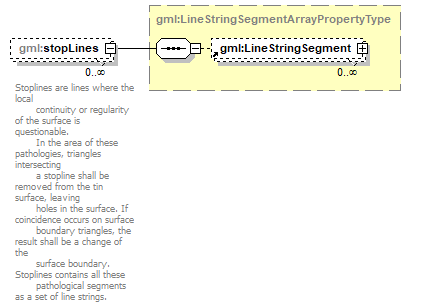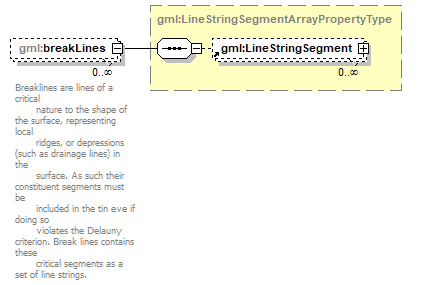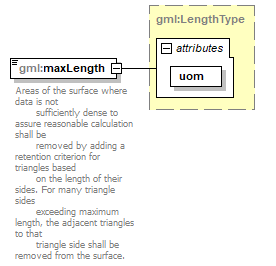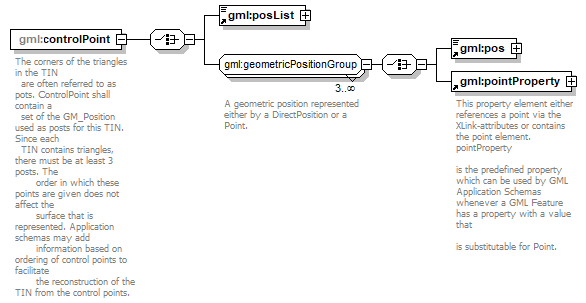| diagram |  |
||||||||||||||||||||||||||||||||||||||||||||||||||||||
| namespace | http://www.opengis.net/gml | ||||||||||||||||||||||||||||||||||||||||||||||||||||||
| type | extension of gml:TriangulatedSurfaceType | ||||||||||||||||||||||||||||||||||||||||||||||||||||||
| properties |
|
||||||||||||||||||||||||||||||||||||||||||||||||||||||
| children | gml:metaDataProperty gml:description gml:name gml:trianglePatches gml:stopLines gml:breakLines gml:maxLength gml:controlPoint | ||||||||||||||||||||||||||||||||||||||||||||||||||||||
| used by |
|
||||||||||||||||||||||||||||||||||||||||||||||||||||||
| attributes |
|
||||||||||||||||||||||||||||||||||||||||||||||||||||||
| annotation |
|
||||||||||||||||||||||||||||||||||||||||||||||||||||||
| source | <xs:complexType name="TinType"> <xs:annotation> <xs:documentation>A tin is a triangulated surface that uses the Delauny algorithm or a similar algorithm complemented with consideration of breaklines, stoplines, and maximum length of triangle sides. These networks satisfy the Delauny's criterion away from the modifications: Fore each triangle in the network, the circle passing through its vertices does not contain, in its interior, the vertex of any other triangle.</xs:documentation> </xs:annotation> <xs:complexContent> <xs:extension base="gml:TriangulatedSurfaceType"> <xs:sequence> <xs:element name="stopLines" type="gml:LineStringSegmentArrayPropertyType" minOccurs="0" maxOccurs="unbounded"> <xs:annotation> <xs:documentation>Stoplines are lines where the local continuity or regularity of the surface is questionable. In the area of these pathologies, triangles intersecting a stopline shall be removed from the tin surface, leaving holes in the surface. If coincidence occurs on surface boundary triangles, the result shall be a change of the surface boundary. Stoplines contains all these pathological segments as a set of line strings.</xs:documentation> </xs:annotation> </xs:element> <xs:element name="breakLines" type="gml:LineStringSegmentArrayPropertyType" minOccurs="0" maxOccurs="unbounded"> <xs:annotation> <xs:documentation>Breaklines are lines of a critical nature to the shape of the surface, representing local ridges, or depressions (such as drainage lines) in the surface. As such their constituent segments must be included in the tin eve if doing so violates the Delauny criterion. Break lines contains these critical segments as a set of line strings.</xs:documentation> </xs:annotation> </xs:element> <xs:element name="maxLength" type="gml:LengthType"> <xs:annotation> <xs:documentation>Areas of the surface where data is not sufficiently dense to assure reasonable calculation shall be removed by adding a retention criterion for triangles based on the length of their sides. For many triangle sides exceeding maximum length, the adjacent triangles to that triangle side shall be removed from the surface.</xs:documentation> </xs:annotation> </xs:element> <xs:element name="controlPoint"> <xs:annotation> <xs:documentation>The corners of the triangles in the TIN are often referred to as pots. ControlPoint shall contain a set of the GM_Position used as posts for this TIN. Since each TIN contains triangles, there must be at least 3 posts. The order in which these points are given does not affect the surface that is represented. Application schemas may add information based on ordering of control points to facilitate the reconstruction of the TIN from the control points.</xs:documentation> </xs:annotation> <xs:complexType> <xs:choice> <xs:element ref="gml:posList"/> <xs:group ref="gml:geometricPositionGroup" minOccurs="3" maxOccurs="unbounded"/> </xs:choice> </xs:complexType> </xs:element> </xs:sequence> </xs:extension> </xs:complexContent> </xs:complexType> |
element TinType/stopLines
| diagram |  |
||||||||
| namespace | http://www.opengis.net/gml | ||||||||
| type | gml:LineStringSegmentArrayPropertyType | ||||||||
| properties |
|
||||||||
| children | gml:LineStringSegment | ||||||||
| annotation |
|
||||||||
| source | <xs:element name="stopLines" type="gml:LineStringSegmentArrayPropertyType" minOccurs="0" maxOccurs="unbounded"> <xs:annotation> <xs:documentation>Stoplines are lines where the local continuity or regularity of the surface is questionable. In the area of these pathologies, triangles intersecting a stopline shall be removed from the tin surface, leaving holes in the surface. If coincidence occurs on surface boundary triangles, the result shall be a change of the surface boundary. Stoplines contains all these pathological segments as a set of line strings.</xs:documentation> </xs:annotation> </xs:element> |
element TinType/breakLines
| diagram |  |
||||||||
| namespace | http://www.opengis.net/gml | ||||||||
| type | gml:LineStringSegmentArrayPropertyType | ||||||||
| properties |
|
||||||||
| children | gml:LineStringSegment | ||||||||
| annotation |
|
||||||||
| source | <xs:element name="breakLines" type="gml:LineStringSegmentArrayPropertyType" minOccurs="0" maxOccurs="unbounded"> <xs:annotation> <xs:documentation>Breaklines are lines of a critical nature to the shape of the surface, representing local ridges, or depressions (such as drainage lines) in the surface. As such their constituent segments must be included in the tin eve if doing so violates the Delauny criterion. Break lines contains these critical segments as a set of line strings.</xs:documentation> </xs:annotation> </xs:element> |
element TinType/maxLength
| diagram |  |
||||||||||||
| namespace | http://www.opengis.net/gml | ||||||||||||
| type | gml:LengthType | ||||||||||||
| properties |
|
||||||||||||
| attributes |
|
||||||||||||
| annotation |
|
||||||||||||
| source | <xs:element name="maxLength" type="gml:LengthType"> <xs:annotation> <xs:documentation>Areas of the surface where data is not sufficiently dense to assure reasonable calculation shall be removed by adding a retention criterion for triangles based on the length of their sides. For many triangle sides exceeding maximum length, the adjacent triangles to that triangle side shall be removed from the surface.</xs:documentation> </xs:annotation> </xs:element> |
element TinType/controlPoint
| diagram |  |
||||
| namespace | http://www.opengis.net/gml | ||||
| properties |
|
||||
| children | gml:posList gml:pos gml:pointProperty | ||||
| annotation |
|
||||
| source | <xs:element name="controlPoint"> <xs:annotation> <xs:documentation>The corners of the triangles in the TIN are often referred to as pots. ControlPoint shall contain a set of the GM_Position used as posts for this TIN. Since each TIN contains triangles, there must be at least 3 posts. The order in which these points are given does not affect the surface that is represented. Application schemas may add information based on ordering of control points to facilitate the reconstruction of the TIN from the control points.</xs:documentation> </xs:annotation> <xs:complexType> <xs:choice> <xs:element ref="gml:posList"/> <xs:group ref="gml:geometricPositionGroup" minOccurs="3" maxOccurs="unbounded"/> </xs:choice> </xs:complexType> </xs:element> |
XML Schema documentation generated by XMLSpy Schema Editor http://www.altova.com/xmlspy